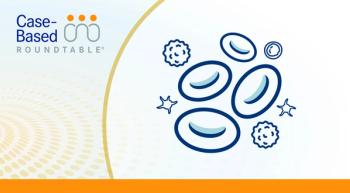
Encouraging Phase I Data for CC-93269 in Multiple Myeloma Reveals T-Cell Engager to Be Safe, Effective
Encouraging signs of dose-dependent efficacy, as well as a promising safety profile, were observed in patients with heavily pretreated relapsed/refractory multiple myeloma who were treated with CC-93269, a human IgG1-based T-cell engager that binds to BCMA and CD3 epsilon in a 2+1 format.
Luciano J. Costa, MD, PhD
Encouraging signs of dose-dependent efficacy, as well as a promising safety profile, were observed in patients with heavily pretreated relapsed/refractory multiple myeloma who were treated with CC-93269, a human IgG1-based T-cell engager that binds to BCMA and CD3 epsilon in a 2+1 format.
"The safety profile of CC-93269 supports further development, and enrollment is ongoing trying to define the recommended phase II dose and optimal schedule. Most of the grade 3 or higher adverse events were neutropenia, anemia, and infections," Luciano J. Costa, MD, PhD, said during a presentation of phase I results at the 2019 ASH Annual Meeting. "CC-93269 shows promising dose-dependent efficacy, including MRD-negative [strigent complete responses], with a convenient administration schedule in patients with heavily pretreated relapsed/refractory multiple myeloma."
In the dose-escalation trial, the 10 mg dose of CC-93269 induced an objective response rate (ORR) for 88.9% of patients, which included a complete remission (CR) or stringent CR (sCR) rate of 44.4%. Many of these responses tested negative for minimal residual disease (MRD). However, cytokine release syndrome (CRS) occurred in 76.7% of patients, which was mostly grade 1 or 2 in severity, warranting further investigation. According to Costa, of the Division of Hematology and Oncology at the University of Alabama at Birmingham, a recommended phase II dose has not yet been determined.
The study included 30 patients with relapsed/refractory multiple myeloma who had received ≥3 prior therapies. The median age of patients was 64 years and the median time from diagnosis was 5.94 years. The most common ECOG performance score was 1 (73.3%) and patients were evenly distributed across ISS stages I, II, and III. A third of patients (30%) had high-risk cytogenetics.
In the dose-escalation phase of the study, doses ranged from 0.15 mg to 10 mg. Treatment with CC-93269 was given on days 1, 8, 15, and 22 in cycle 1 to 3 then on days 1 and 15 in cycle 4 to 6. For cycle 7 and up to 2 years, the treatment was administered on day 1 alone. In response to the rates of CRS observed, additional cohorts were added with intra-patient dose escalation. In one of these cohorts, patients started at 6 mg with the dose increasing to 10 mg (cohort 7). Additionally, patients were stratified between cohort 8 and cohort 9 based on whether they had low or high tumor burden, respectively. In these cohorts, the dose was started at 3 mg and escalated to 6 mg.
A response to CC-93269 was not observed for any patients receiving a dose of ≤3 mg (n = 7). In cohorts 8 and 9 and those receiving CC-93269 at 6 mg (n = 14), the ORR was 35.7%, which included an sCR/CR rate of 7.1% and a very good partial response (VGPR) rate of 7.1%. In the largest dose arms (cohort 7 and those receiving 10 mg), the ORR was 88.9%, which included an sCR/CR rate of 44.4% and a VGPR rate of 33.3%. There was a dose-dependent decrease seen in serum M protein, size of measurable disease, and serum-free light chains in response to treatment with CC-93269.
The median time to first response was 4.1 weeks (range, 4.0-13.1). Eleven of the 13 observed responses remained ongoing at the assessment. Of these responses, 92.3% were negative for MRD (≤1/105) in the bone marrow.
Treatment-emergent adverse events (TEAE) were experienced by 96.7% of patients, of which 73.3% was grade ≥3 in severity. The most common grade ≥3 TEAEs were hematologic, including neutropenia (43.3%) and anemia (36.7%). Most of the non-hematologic TEAEs were grade 1 or 2 in severity. The most common TEAEs of all grades were CRS (76.7%), infections and infestations (56.7%), diarrhea (26.7%), and vomiting (26.7%). Grade ≥3 non-hematologic AEs included infections and infestations (30%), CRS (3.3%), and diarrhea (3.3%).
Almost all of the CRS events occurred after the first dose of CC-93269 and then tapered off with subsequent doses (23.3% after second dose and 7.4% after third dose). There was one grade 5 CRS event at the 10 mg dose. Tocilizumab was administered for 43.3% of patients and corticosteroids were administered for 73.3%. Dexamethasone prophylaxis is now being required for all patients receiving a dose of ≥6 mg.
In pharmacodynamic findings, there was a dose-dependent change in immune cell redistribution and cytokine release. Pharmacokinetics showed target-mediated drug disposition and a dose-proportional response. In these analyses, anti-drug antibodies were not observed.
The phase I study continued to enroll participants, with a total enrollment goal of 120. The estimated primary completion date is July 2021 (NCT03486067).
Reference:
Costa LJ, Wong SW, Bermudez A, et al. First clinical study of the B-cell maturation antigen 2+1 T cell engager CC-93269 in patients with relapsed/refractory multiple myeloma: interim results of a phase 1 multicenter trial. Presented at: 2019 ASH Annual Meeting; December 7-10, 2019; Orlando, FL. Abstract 143.








































